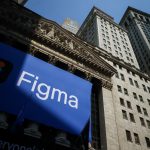
- Enterprise Software
- IPO
- Stock Market
Figma Sets $16.4B IPO Target After Adobe Deal Collapse
5 minute read

Design software leader Figma pursues public market debut amid growing tech IPO momentum after Adobe deal collapse
Key Takeaways
- $979 million capital raise targeted as Figma sets IPO price range of $25-$28 per share, seeking valuation up to $16.4 billion
- Adobe acquisition fallout drives independence after $20 billion deal collapsed due to regulatory opposition in 2022
- $70 million bitcoin investment signals treasury diversification with plans to allocate additional $30 million to cryptocurrency holdings
Introduction
Design software company Figma advances toward one of 2025’s most significant tech IPOs, setting a price range that positions the company for a potential $16.4 billion valuation. The collaborative design platform plans to offer 36.94 million shares between $25 and $28 each, targeting approximately $979 million in capital at the midpoint price.
This public offering marks a pivotal moment for Figma, demonstrating the company’s ability to command premium valuations independently after regulatory authorities blocked Adobe’s proposed $20 billion acquisition in 2022. The NYSE listing under ticker symbol “FIG” represents a significant test case for investor appetite toward high-growth SaaS platforms.
Key Developments
Figma officially launched its IPO roadshow this month, offering nearly 37 million Class A shares through a combination of primary and secondary offerings. The pricing structure aims for a market value of $15.9 billion at the range’s midpoint, according to Renaissance Capital analysis.
The targeted valuation exceeds Figma’s last private valuation of $12.5 billion, achieved through a tender offer that allowed early employees and investors partial liquidity. However, the IPO valuation remains below Adobe’s original $20 billion acquisition proposal, reflecting current market conditions and investor selectivity.
Morgan Stanley, Goldman Sachs, and J.P. Morgan lead the underwriting syndicate, with pricing expected during the week of July 28, 2025. The offering includes both new shares for capital raising and existing shares from current stakeholders seeking partial exits.
Market Impact
The IPO arrives amid a recovering market for tech listings, with global IPO value growing 20% year-over-year in Q1 2025. However, investor sentiment remains cautious, with fewer than half of new listings delivering first-day gains despite median returns increasing 3-5%.
Figma’s cryptocurrency holdings add an unconventional element to its investment proposition. The company maintains approximately $70 million in Bitwise’s bitcoin exchange-traded fund and plans to allocate an additional $30 million to bitcoin investments, representing a notable treasury diversification strategy among IPO candidates.
The timing follows successful debuts from other high-profile companies, including stablecoin platform Circle, which generated substantial investor gains following its recent listing. This momentum contributes to growing optimism around quality tech offerings.
Strategic Insights
Figma’s business model centers on subscription-based collaborative design tools serving over 13 million monthly users across 150+ countries. Approximately 85% of monthly active users operate outside the United States, highlighting the platform’s global reach and revenue diversification.
The company’s evolution from browser-based UI design tool to comprehensive product development platform positions it within broader digital transformation trends. This expansion strategy differentiates Figma from traditional design software competitors and supports premium valuation multiples.
The failed Adobe acquisition paradoxically strengthens Figma’s independent growth narrative. Regulatory opposition demonstrated the platform’s competitive significance while allowing management to pursue organic expansion strategies without integration constraints.
Expert Opinions and Data
According to Bloomberg, investors closely monitor this offering as a significant indicator of design software market dynamics. Industry analysts view Figma’s pricing discipline as evidence of management’s market awareness and realistic valuation expectations.
Renaissance Capital’s valuation analysis suggests the midpoint pricing reflects balanced positioning between private market valuations and public market scrutiny. The approach acknowledges current investor preferences for profitable, sustainable business models over pure growth metrics.
Founder Dylan Field previously emphasized preparedness for “big swings” in strategic decisions, reflecting management’s adaptability following the Adobe acquisition collapse. This flexibility now extends to unconventional treasury management through cryptocurrency investments, viewed by some analysts as bold differentiation while others note potential volatility risks.
Conclusion
Figma’s IPO serves as a crucial benchmark for growth-stage SaaS company valuations in the current market environment. The offering combines proven subscription revenue models with global user scale and strategic diversification through cryptocurrency holdings.
The company’s journey from near-acquisition to independent public listing demonstrates resilience and validates collaborative design software as a sustainable, scalable business category. Success in this offering could encourage additional tech companies to pursue public markets, potentially accelerating the broader IPO recovery trend.








